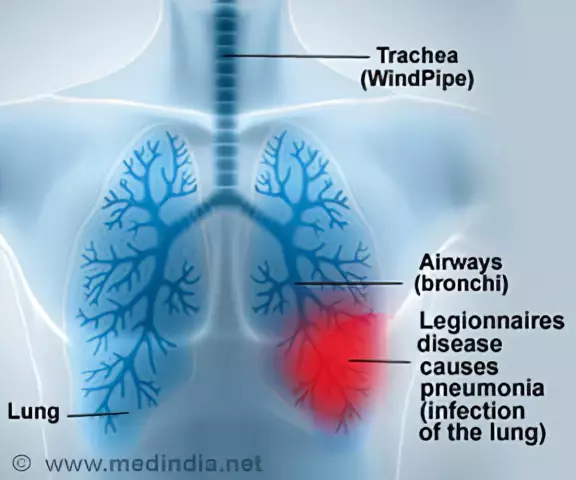- Author Rachel Wainwright [email protected].
- Public 2023-12-15 07:39.
- Last modified 2025-11-02 20:14.
Legionnaires' disease

Legionnaires' disease is one of the clinical forms of the infectious disease Legionellosis, characterized by an acute course, which is caused by various types of microorganisms from the genus Legionella.
Legionnaires' disease (aka Pontiac fever, Pittsburgh pneumonia, Fort Bragg fever, or Legionella infection) typically occurs with:
- General intoxication;
- Severe fever;
- Syndrome of multiple organ failure;
- Damage to the central nervous system, lungs, digestive organs.
Prevalence of Legionnaires' disease
The main habitats of pathogens (Legionella) in nature are soil and water. Along with natural springs, there are also artificial water systems in which water circulates at an optimal temperature for the reproduction of bacteria. Legionella develops in air conditioner fluids, refrigeration systems, and warm waters discharged from power plants.
Despite the severity of this disease, the causative agent of Legionnaires' disease does not pose an epidemic danger, and contaminated equipment is usually sanitized.
Legionellosis is an infectious disease, but its prevalence is determined not so much by natural and climatic conditions as by an anthropogenic factor. The overall incidence of Legionnaires' disease worldwide is not high, but there are sporadic outbreaks in different countries every year.
At the same time, it is noted that travelers who often change their location are more prone to illness. This is due to a constant change in the body's resistance and more frequent contact with sources of infection.
Course of the disease
The causative agent of Legionnaires' disease enters the body through the mucous membrane of the respiratory tract by inhalation of water aerosols, which may include:
- Shower and bath;
- Fountains;
- Ultrasonic water sprayers;
- Air conditioners;
- Humidifiers for artificial ventilation systems.
At the same time, the fact of transmission of infection from person to person has not been recorded.

Most cases of legionellosis are associated with lung damage. Pathological changes usually affect at least one lobe of the lung, spreading to the terminal bronchioles and alveoli.
The disease is characterized by pronounced edema of the interstitial tissue, and its course resembles drainage pneumonia.
Risk factors for the development of Legionnaires' disease in severe community-acquired pneumonia are:
- The presence of concomitant diseases, namely diabetes mellitus, cardiovascular diseases and diseases that are accompanied by a course of systemic hormonal or intensive immunosuppressive therapy;
- Warm season;
- Male gender;
- Smoking;
- Age over 40;
- Alcohol abuse;
- Travel within the country or abroad 2-10 days before the onset of the disease (incubation period).
Legionnaires' disease symptoms
The short prodromal period of the disease is characterized by anorexia, increased fatigue, and moderate headache. In some cases, transient diarrhea may be another symptom of Legionnaires' disease.
Then there is a sharp deterioration in the condition with a rapid increase in body temperature (up to 40 ° C), which is accompanied by increased headache, chills, pain in muscles and joints, increasing adynamia.
Usually on the first day of illness, the cough is dry, and the mucous and purulent-mucous component of sputum appears somewhat later. Hemoptysis is extremely rare. At this stage, the disease may be accompanied by intense stitching pain in the chest, usually worsening with deep breathing and coughing. Increasing acute respiratory failure may also develop, which requires respiratory support.
Legionnaires' disease, in addition to the lungs, often affects other systems and organs, among which it is noted:
- Increased liver size;
- Lesions of the gastrointestinal tract, including vomiting, nausea, abdominal pain, diarrhea;
- Acute renal failure;
- Disorientation in place and time, impaired consciousness, dysarthria;
- Cerebellar disorders;
- Convulsions.
The febrile period in Legionnaires' disease, as a rule, lasts at least two weeks, after which, with favorable treatment, a slow recovery begins with a rather long preservation of the phenomena of asthenia. In a severe course of the disease, a lethal outcome is possible due to increasing respiratory or multiple organ failure.
YouTube video related to the article:
The information is generalized and provided for informational purposes only. At the first sign of illness, see your doctor. Self-medication is hazardous to health!






